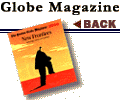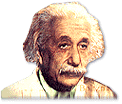Eureka!
Einstein wasn't a team player
By John Yemma, Globe Staff
For much of this century, the great scientists were as well known as sports
heroes and movie stars. They were the Promethean personalities who brought the fire of modern technology to mankind. Most people had at least a passing familiarity with these characters, their inventions and discoveries, their looks and quirks:
Thomas Edison. Big-boned and arrogant. Sloppy dresser. Went deaf. Light bulb, phonograph.
Albert Einstein. Lovable, pipe-smoking genius. Fuzzy hair, rumpled sweaters. E=MC2.
Guglielmo Marconi. Starched-collar Italian. Peace activist. Invented radio. Sent Morse code across the Atlantic.
As the century ends, there's not one scientist around with the name recognition of an Edison, Einstein, or Marconi. Yes, many people are familiar with Stephen Hawking, but that is mostly because of his plight - his brilliant brain trapped inside his profoundly crippled body, his synthesized voice delivered via computer. Few people can name the field he is associated with (quantum cosmology). Fewer still can explain it.
No, science today has become an elaborate collective endeavor in which scientists work on incremental developments of increasingly rarefied subjects - stochastics, chaos theory, genetic algorithms - within university, corporate, or government laboratories. Never has science been more central to society. It is the fuel of the information-age economy, the currency of global competition. And never have scientists been more anonymous, what they do more baffling - at least to the general public.
Listen to Karl Stephan, a 45-year-old professor of electrical engineering at the University of Massachusetts at Amherst: ''I was drawn to science because of the romanticized image - Edison, Charles Steinmetz, Nikola Tesla, Marconi. That's gone now. Tinkering in the sense of building with your hands has largely vanished. If there is romanticism in science now, it is in a different form.''
Stephan haunted Radio Shack when he was young. He fiddled with knobs and switches. Today, he says, a young scientist is liable to do computer hacking, virtual tinkering. Sure, there are still basement inventors, many of them playing around with old technology. But that is a backwater, a hobby. It is not the leading edge of science.
That edge is difficult for most lay people to get their minds around. It is all about complexity - specifically, ''complex systems'' such as biological signaling, ecological behavior, climate modeling. This is the opposite of the reductionist science that most people grew up with, the simplify-it science that produced sleek theories about atomic structure and the nature of electromagnetism. Reductionism was naturally suited to a single brilliant thinker - an Einstein or a Michael Faraday - who could pare a problem to an elegant formula.
E=MC2 is a stunningly spare reduction that relates energy to matter. There are still scientists working on reductions today. Many are trying, for instance, to relate the four fundamental forces of matter (electromagnetism, gravity, the ''strong'' force that holds atoms together, and the ''weak'' one that produces radiation), but what they almost certainly will come up with will be a l-o-n-g formula. Happily, computers are well suited to processing l-o-n-g formulas. Unhappily, humans have a hard time getting their minds around them.
Heading into the 21st century, most big scientific efforts involve overlap, cross-pollination, interdisciplinary teamwork, and l-o-n-g formulas. Here is how Janie Fouke, a member of the National Science Foundation and a professor of electrical engineering at Case Western Reserve University in Cleveland, explains 21st-century science: ''All the interesting problems right now are at the interface between disciplines. It is very fluid and nonlinear, like particles changing tracks.''
Does that help? Probably not. Even scholars have difficulty getting a grip on this, says Fouke. ''The boundaries - the traditional academic departments - often get in the way of multidisciplinary work, whether in apportioning credit, judging a scholar for promotion, or bestowing recognition.'' In other words, if you mess around outside your discipline, you might end up without tenure, you might never get an office with a window.
But as long as you have an Internet link, you will have all the window that you need, says Arun Netravali, head of research at Lucent Technologies' Bell Laboratories. This is how his organization develops complex new software: ''We work on it here in New Jersey,'' he says, ''and at the end of the day, we forward it to Hong Kong or India to work on, and they forward it to Europe next. It is a 24-hour process. We get things done much faster. And it has another benefit. Scientists are more willing to stay where they are rather than move around, because they are on the network.''
Netravali agrees that the general public no longer associates science with marquee names or light-bulb inventions. Nevertheless, he says, the scientists working on complex tasks in these globe-girdling networks often are pursuing ideas that emerge from a single brilliant scientist, or a handful of them. Coming up with the idea is not all there is to science, especially now. ''The idea is really a small part of a research project. There's so much more work to do,'' he says.
Most scientists agree with this. The individual scientist has not become a small cog inside a vast research machine, they say. He or she is a treasured, often-pampered, frequently indulged asset, even for the biggest, most bottom-line-oriented companies. Unfortunately, the public still wants its scientists to be like Edison and Einstein - lone-wolf thinkers who, preferably, dropped out of formal education and, in the face of opposition from a skeptical scientific establishment, came up with astounding breakthroughs. The public wants twitchy oddballs in lab coats, muttering to themselves as they pour colored water from beakers into test tubes.
This may explain, in part, the stir created by Martin Fleischmann and Stanley Pons with their 1989 ''discovery'' of cold fusion, which they said they could achieve with a few dollars worth of off-the-shelf lab equipment. They were quirky iconoclasts (sloppy dressers, lovers of Scotch whiskey), and they seemed to have something that stood conventional science on its ear, promising unlimited clean energy such as is produced by the sun. The public ate it up. Trouble is, cold fusion didn't pan out - although there are true believers out there, including Fleischmann and Pons, who say mainstream science is deliberately ignoring their work.
For now, we are left with hot fusion, a massive research project involving thousands of scientists working in labs and hunched over computers from Cambridge to Nagoya, a project that employs incredibly complicated machines such as the gigantic laser arrays harnessed to supercomputers at the National Ignition Facility in Livermore, California. It is expensive. It is difficult to comprehend. Progress is measured in tiny gains. There is little fun and very little that is sexy going on here. But the fact remains that fusion can't be done in jelly jars on the kitchen sink. You may know the name Bill Gates. You may know Steve Jobs. But, as much as they have affected our lives, they are entrepreneurs more than scientists. So where are the heroes of science? Bernie Meyerson thinks about that a lot. At IBM, where he works, he is something of a hero - an ''individual yahoo'' is how he puts it. Science heroes, he thinks, flourish even at $85 billion companies like IBM, companies that once were the very essence of gray-flannel, innovation-snuffing conformity. ''Most people,'' he says, ''have no clue that within IBM we have a culture where we protect the creative people with vehemence.''
Because it needs the individual iconoclastic scientists to come up with new ideas, IBM allows researchers like Meyerson to tinker. In the early 1980s, Meyerson began playing with an alloy called silicon-germanium, which he thought could allow him to make much more powerful transistors to run faster mainframe computers. He developed and patented a refining process for the alloy. As it turned out, silicon-germanium was not needed in mainframes. Its best use is in communications devices. According to industry estimates, silicon-germanium will be a $1.8 billion industry by 2005.
IBM, Meyerson says, is quite happy to have a big piece of that. And Meyerson is quite happy with the arrangement.
''The yahoos who are good,'' says Meyerson, ''are the ones who know they can't tinker on their own forever.''
|



![]()
![]()





